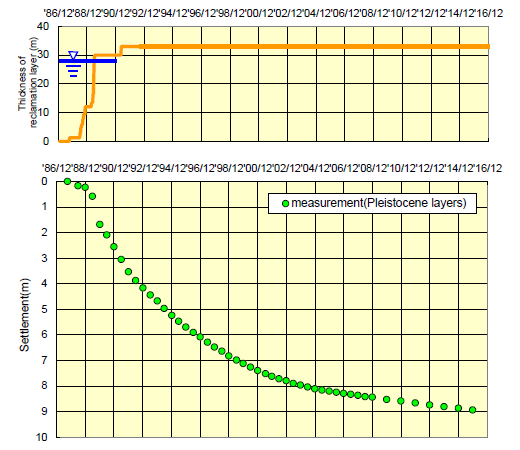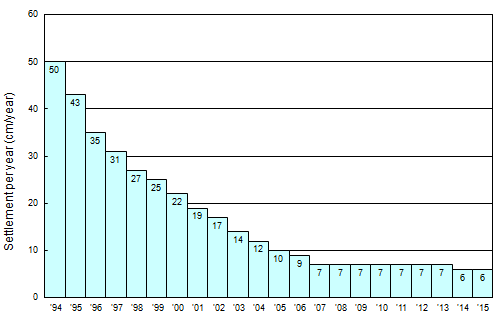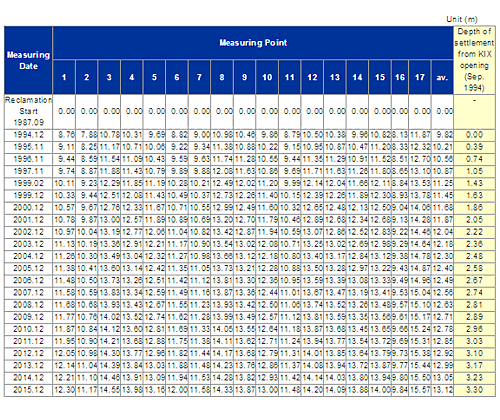Characteristics of the Settlement of the Holocene Layer and the Ground Reformation
The soft holocene clay layer in the upper layers of the seabed is the same clay that can be found at any seashore. Technical measures against the settlement of soft holocene clay layers have been in process for many years. As a result, we have extensive knowledge and experience in the characteristics of settlement of those layers.
The land of Kansai International Airport settles due to its own weight to a significant degree: the thickness of the holocene clay layer decreases to two thirds of its original thickness. Additionally, the distance between the surface of the top layer and the sea level is small, so uneven spots on the surface of the top layer would likely have adverse effects on the airport facilities. So it was essential to reform the soil of the seabed.
It is impossible to stop the settlement of the holocene clay layer found beneath the KIX complex. However, we can minimize the bad effects of the settlement by artificially speeding up the process. We employed the sand drain method. The settlement would otherwise have taken decades without intervention. We have successfully speeded up and completed the settlement process of the holocene clay layer in less than a year.

Mechanism of the Sand Drain Method

Mechanism of the Sand Drain Method Work Barge for the Sand Drain
The Sand Drain method calls for driving sand drains into the clay layer to let the water out of the clay layer as fast as possible. The method speeds up the settlement and brings it to an end. It also hardens the clay layer. We drove a million sand drains (20 m long and 40 cm in diameter) at 2.5 m-intervals into the clay layer under the first island. We installed 1.2 million sand drains for the second island. The sand drain method was first used in Japan in 1952. In the 35 years from then until the KIX construction, the total number of sand drains installed in Japan was only 900 thousand. This gives an idea about the scale of the KIX construction!
The settlement data of the holocene clay layer that we have been collecting for the first island since the reclamation began shows that settlement ended in less than a year after the reclamation land was loaded on and the method began to exert its effect on the settlement of the holocene clay layer. The KIX reclamation land has sunk very little since the alluvial settlement ended. Now settlement has completely ended.

An example of Settlement of Holocene Layer
Characteristics of the Settlement of the Pleistocene Layer
The settlement of the holocene clay layer ended during the construction of Kansai International Airport. The long-lasting, and ongoing settlement under the KIX islands since its opening is taking place in the Pleistocene layer.
The Pleistocene clay layer is so thick and hard that no soil reformation is possible such as what we have done to the holocene clay layer. The Pleistocene layer sinks slowly and naturally over the long term.
The settlement data of the Pleistocene clay layer that we have been collecting since the start of construction of the first island shows that filling the sea does not have significant effect on the Pleistocene clay layer because buoyancy decreases the weight of sand, and the weight of the island did not exceed the load bearing capacity of the hard Pleistocene clay layer. However, once the artificial island emerges from the water, settlement begins. The settlement is tending slowly recently.

An example of Settlement of Pleistocene Layers
Settlement of the Ground Surface of the Kansai International Airport
We have been observing the settlement at 17 points on the first island since the commencement of its construction. The settlement we have been observing includes that of the holocene clay layer and that of the Pleistocene layer. The settlement of the holocene clay layer ended less than a year after the reclamation was complete. So the settlement of the KIX island can be almost entirely attributed to the settlement of the Pleistocene layer.
The measurements made in December 2015 show that the depth of the settlement at each point varies depending on the thickness of the clay layer and the weight of the reclamation material. The average depth of settlement since the start of the KIX construction is 13.12 m. The depth of settlement before the opening of KIX was 9.82 m. Consequently, the depth of the settlement since the opening of KIX is 3.30 m. The average depth of settlement at the 17 measuring points was 50 cm per year around the opening of KIX.
The depth is 6 cm per year in 2015.
The depth and the degree of the settlement decrease year by year. It is clear that the settlement is tending steadily towards an end.

settlement per year

elevations on the island (as of December 2015)
In order to understand the future settlement process, the following perspectives are essential:
- A high level perspective that monitors whether the whole settlement is going to continue steadily towards cessation as it has been.
- A detailed perspective that monitors the increase in water-pressure in the second layer under the first island caused by the presence of the second island and its long term affect on the settling of the first island.
- A detailed perspective that monitors which part of the Pleistocene layer sinks and the long term results.
KIAC will continue to gather settlement data and monitor the settlement with help from academic experts.




